7 lessons from Seattle's spectacular protected bike lanes on Broadway
By: Michael Andersen

To see how dramatically Seattle has changed Broadway, just above its downtown, by adding streetcar tracks and one mile of two-way protected bike lane, compare the photo above (from Saturday) to the one below (from Google Street View’s capture of the same stretch of road in 2011).
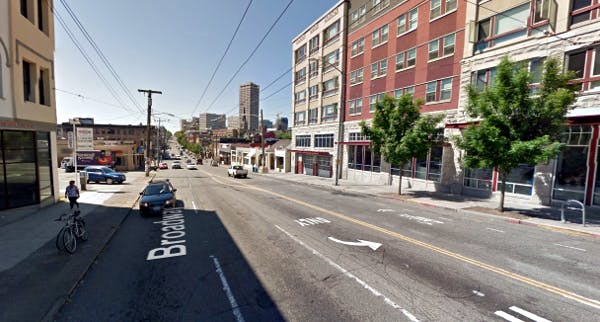
As of this spring, the lanes through Seattle’s First Hill neighborhood connect Seattle Central College, Seattle University, the Swedish Medical Center, a high-density mixed-income housing complex and a significant commercial node that’ll soon be anchored by an underground light rail stop.
Steve Durrant of Alta Planning and Design, a lead consultant on the project, said the lanes allow biking on a major commercial artery that had been “essentially a forbidden street.”
The lanes were created as part of the $134 million First Hill streetcar expansion, paid for by a 2008 transit ballot measure. With space at a premium on the new street, Durrant said, the 10-foot-wide space immediately east of the northbound streetcar tracks were seen as the only viable way to get bike facilities on Broadway.
The resulting lanes are rare in one important way: they create a two-directional protected lane on one side of a two-way street. That’s a little-used design due to the large number of possible turning conflicts. But Seattle is showing that with enough money and care, it can be done.
I stopped by the project last weekend to look at some of the tricks up these lanes’ sleeve.
1) They use creative separation equipment
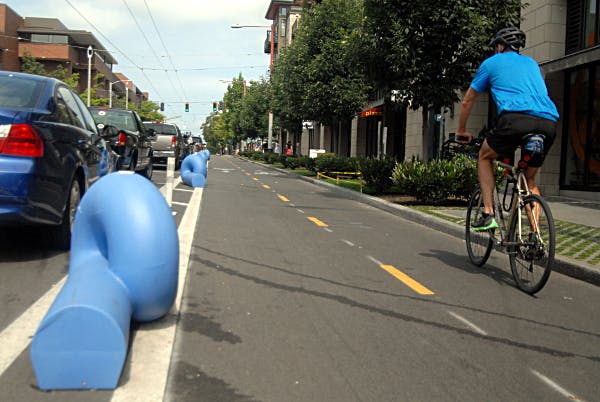
We’re bike lane separation geeks here at the Green Lane Project, but these giant sand-filled blue plastic separators were new to us when Seattle prepared to install them last year. As Seattle Bike Blog put it, Broadway might be the world’s first “Smurf-turd-protected bike lane.” As post-separated lanes around the country are showing their age, Seattle’s choice to use these more durable, visible barriers is looking smart.
2) Every intersection is marked with a green crossbike
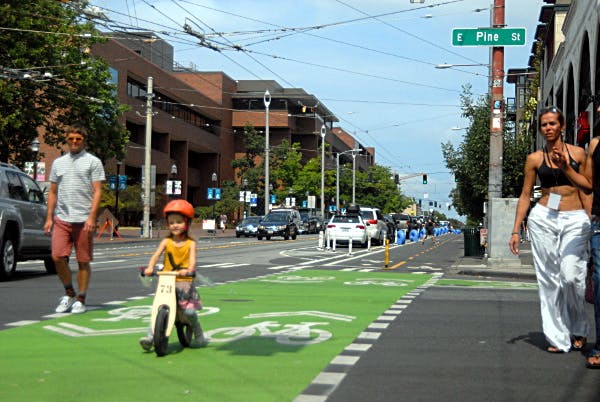
Here’s a scene that hasn’t been seen on streets like Broadway in more than 100 years: a dad helping his daughter practice riding her bike while they head on an errand together.
3) Every driveway crossing is marked in green, too
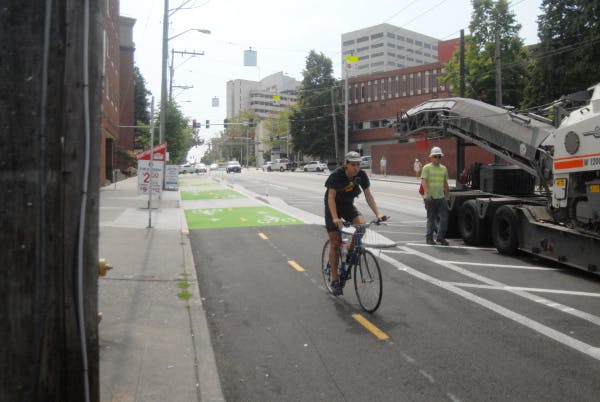
The consistent use of green at street crossings has a side benefit: it makes it more intuitive that in this context, green is being used to mark conflict zones. Every driveway along the lanes is marked with green, including the entrances to parking lots (above). (Also, check out the hatched-off areas near each driveway, signifying that cars shouldn’t park there in order to keep lines of sight clear.
Next to the lane are also a busy gas station with a very long curb cut…
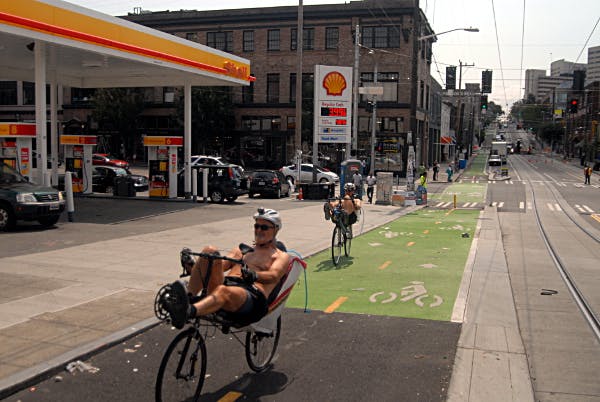
…and little mini-marts.
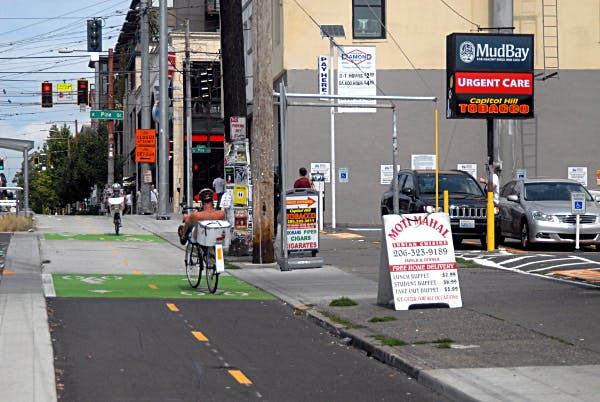
“There are like 2, 3 blocks in there that are really intense with driveways,” Durrant said. “It’s sort of what we were stuck with.” But the result, he said, seems to be fine as long as street users keep their wits about them. “I’ve ridden it now many times, and I haven’t seen a challenge with it.”
4) It rises to sidewalk level behind streetcar stops

Broadway’s bike lanes actually cut the cost of the associated streetcar project significantly, because they run on top of a water line that would have had to be displaced if the streetcar had hugged Broadway’s east curb. This meant the bike lanes run between the transit stop and sidewalk, a setup that’s common in Europe and works just fine in the United States but requires some nuance.
Here, designers raise the bike lane to sidewalk level as a biker approaches the transit stop, communicating to people pedaling that (like a car on a raised crosswalk) they’re no longer in their own space and should yield to pedestrians.
Here’s a similar design on Yesler, at the south end of Broadway’s protected lane:
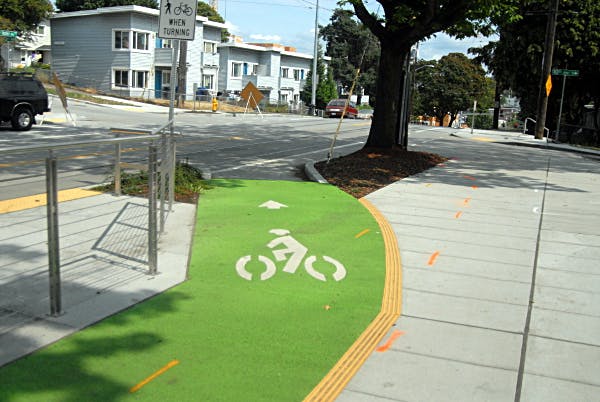
5) It has a dedicated bike signal at every intersection
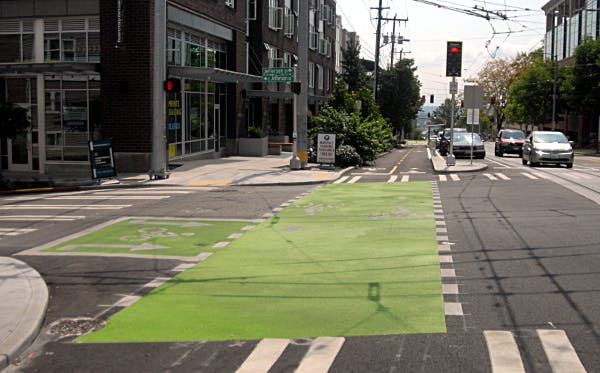
Seattle has one of the country’s stiffest standards for traffic signals on protected bike lanes: at every signalized intersection — which is, in Broadway’s case, all of them — bikes get either their own signal phase or a three-second head start on cars after each red light. Sometimes, as above, that means creating a freestanding post for the bike lane (a significant expense) and sometimes (as below) it means an extra signal box hanging from the same wire as others.
6) Most signals have underground detection loops
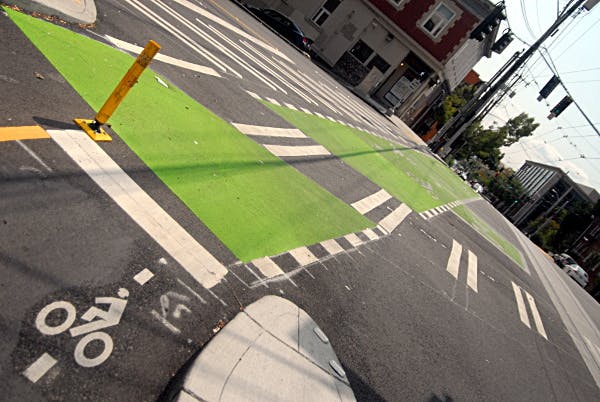
Place your wheels over these vertical white bars and the intersection will detect that someone is on a bike, waiting for a green light. Though these stencils are proven not to be very intuitive, they work — and the more they’re used, the more people will understand how useful they are.
Now, here’s one related problem that seems to have popped up…
7) The “no right turn” signals are often being ignored
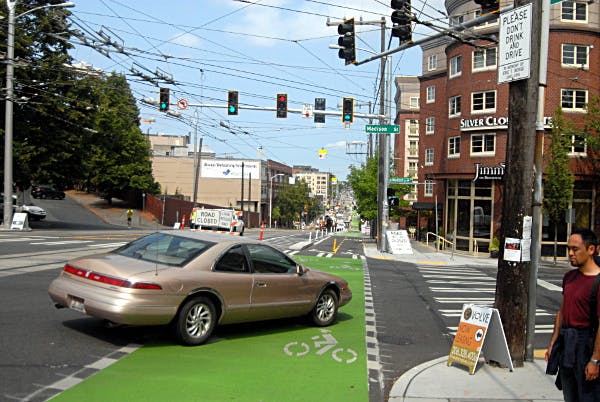
The downside of dedicated signal phases is that many people in cars aren’t expecting them. Above was one of the four cars I saw approach this intersection while cars had a red arrow but bikes have a green bike signal. Of those, three illegally turned right across the bike lane despite a “No turn on (red dot)” sign.
I wondered if people were simply looking at the rightmost signal and assuming it applied to right-turning cars without noticing the bicycle shape inside the signal head. One way to fight this misconception would be to put the bike signal lower or on the near side of the intersection, away from those that apply to cars. Another might be for the “no turn” sign to picture a red arrow rather than a red dot.
Maybe this is just one more mark in the case against turn lanes, or the case against right turns on red in general.
Durrant, the designer, had his own suggestion for a fix.
“Enforcement,” he said.
